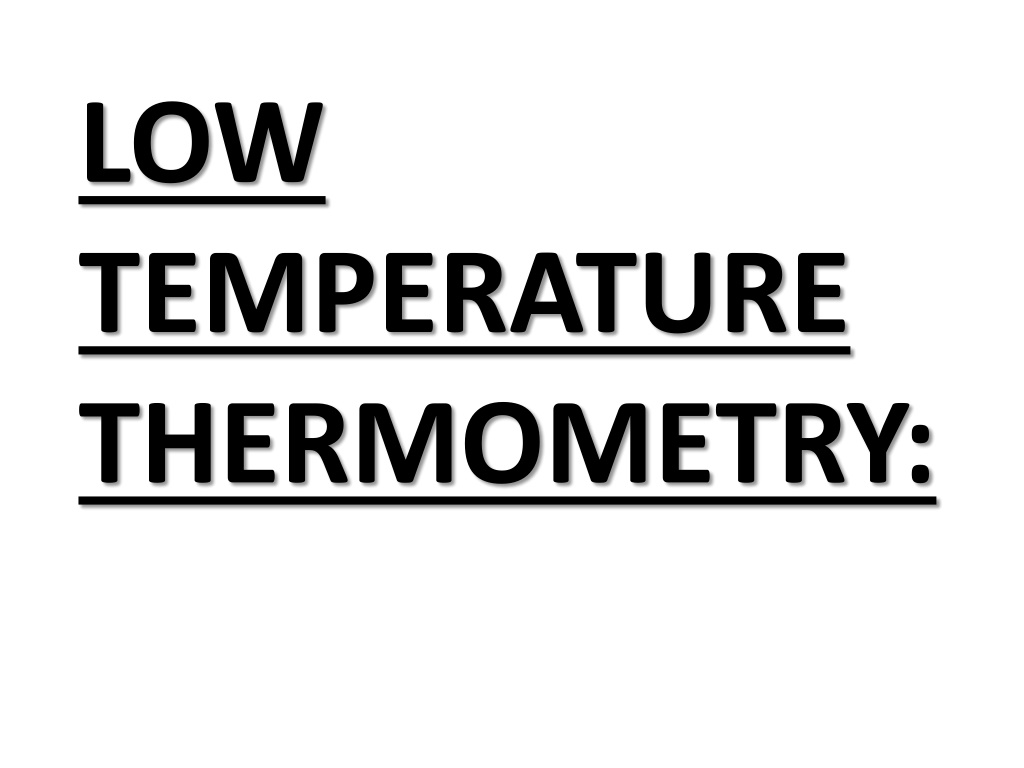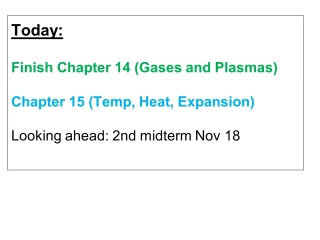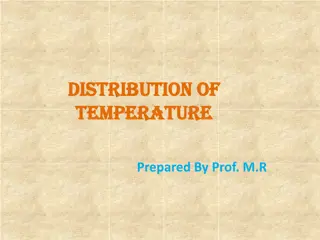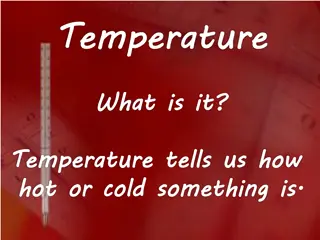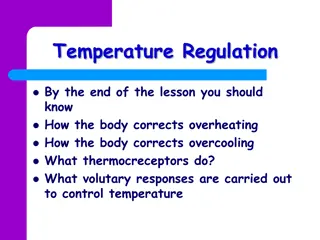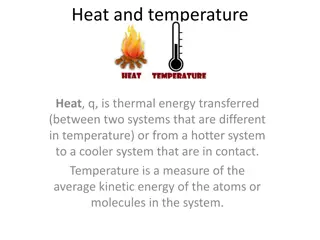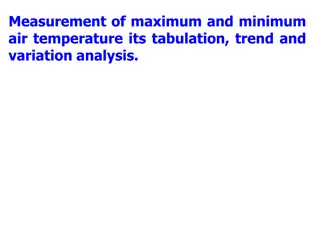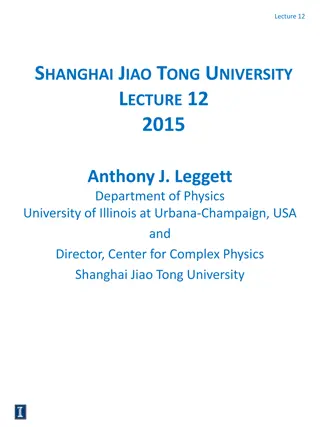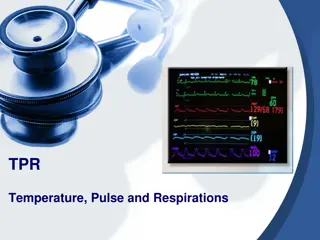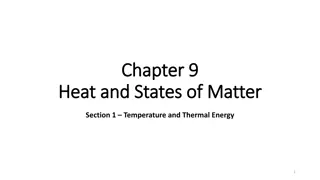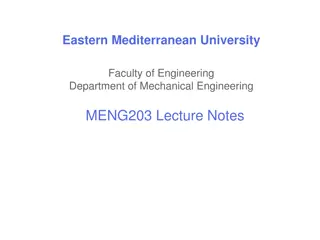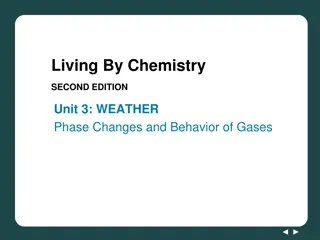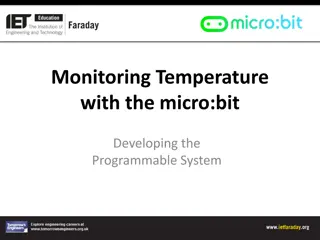Low Temperature Thermometry Overview
Temperature measurement, known as thermometry, involves assessing local temperature levels for various applications. A good low-temperature thermometer should offer reproducibility, high sensitivity, and a wide operating range. Primary thermometers directly measure properties of matter, while secondary thermometers require calibration against primary ones. Gas thermometers are primary thermometers that rely on gas behavior following pressure and temperature changes. Secondary thermometers like vapor pressure thermometers offer simpler and more accurate low-temperature measurements.
Download Presentation

Please find below an Image/Link to download the presentation.
The content on the website is provided AS IS for your information and personal use only. It may not be sold, licensed, or shared on other websites without obtaining consent from the author.If you encounter any issues during the download, it is possible that the publisher has removed the file from their server.
You are allowed to download the files provided on this website for personal or commercial use, subject to the condition that they are used lawfully. All files are the property of their respective owners.
The content on the website is provided AS IS for your information and personal use only. It may not be sold, licensed, or shared on other websites without obtaining consent from the author.
E N D
Presentation Transcript
LOW TEMPERATURE THERMOMETRY:
Contents Primary thermometers. Gas thermometers. Secondary thermometers. Vapour pressure thermometers. Resistance thermometers: Metals, alloys and semiconductors. Thermoelectric thermometers. Magnetic thermometers.
Temperature measurement, also known as thermometry, describes the process of measuring a current local temperature for immediate or later evaluation. A thermometer measures a property of matter which is a function of temperature. Since most of the properties of materials depend on temperature, there are a lot of possible choices for a thermometer. A good low-temperature thermometer should possess several qualities: reproducibility and high sensitivity; a wide operating range and low sensitivity to environmental changes such as magnetic or stray fields; a short time to reach equilibrium and a fast reading system. Primary and secondary thermometers: A thermometer is called primary or secondary based on how the raw physical quantity it measures is mapped to the temperature. In primary thermometers the measured property of matter is known so well that temperature can be calculated without any unknown quantities. Examples of these are thermometers based on the equation of state of a gas, on the velocity of sound in a gas, on the thermal noise voltage or current of an electrical resistor, and on the angular anisotropy of gamma ray emission of certain radioactive nuclei in a magnetic field. In contrast, Secondary thermometers are most widely used because of their convenience. Also, they are often much more sensitive than primary ones.
For secondary thermometers knowledge of the measured property is not sufficient to allow direct calculation of temperature. They have to be calibrated against a primary thermometer at least at one temperature or at a number of fixed temperatures. Such fixed points, for example, triple points and superconducting transitions, occur reproducibly at the same temperature. Primary thermometers: Gas thermometers: Gas thermometers are primary thermometers. They depend on the behavior of a gas when subjected to changes in pressure and temperature. They work directly on ideal gas law. That is, PV=nRT. For n moles of a gas. There are two types of gas thermometers. They are: 1. Constant pressure gas thermometer: Measuring the volume of a known quantity of gas as a function of temperature, keeping the pressure fixed. 2. Constant volume gas thermometer: Measuring the pressure of a known quantity of gas as a function of temperature, keeping the volume fixed. Primary thermometers are costly and need sophisticated labs to handle. So they are used only for calibrating secondary thermometers, which are used widely due to their convenience to handle and low cost. https://en.wikipedia.org/wiki/Gas_thermometer https://youtu.be/n0xAQXL905c
Secondary thermometers: 1. Vapour pressure thermometers: One of the useful method of low temperature thermometry is the measurement of pressure of vapour above and in equilibrium with its liquid. This method is less complicated and more accurate than gas thermometry since the vapour pressure depends strongly on temperature. We have to obviously choose a particular liquid appropriate to the temperature range used. The substance used must be gaseous at room temperature and liquid at the temperature to be measured. The usual gases therefore for low temperature measurement are oxygen, hydrogen and helium. Vapour pressure data for these gases are available. The relevant formula used for temperature estimation from measured vapour pressure data is the well known Claussius- Clapeyron equation : ?? ??= ? ?(?1 ?2 ) (1) Where P is the pressure, T is the temperature, L is the latent heat of evaporation and v1 and v2 are the specific volumes of vapour and liquid respectively. Upon integration gives a formula of the following type: ???? = ?+ ????? ?? + ? Where a,b,c and k are constants. ? (2)
A vapour pressure thermometer essentially consists of: a bulb containing the pure measuring substance in thermal equilibrium with the sample whose temperature is to be measured; a pressure sensor; a connecting tube long enough to connect the bulb to the pressure sensor; and a valve for filling. The bulb: The bulb can be very small depending upon the quantity of substance necessary to cover the required temperature range. It is necessary to ensure that at no time during temperature cycling the substance reassembles into a single phase. The maximum pressure that will occur determines the thickness of the walls of the bulb. The bulb is formed from a material that is a good heat conductor, is chemically neutral, and neither absorbs nor desorbs gases. Schematic construction of a saturated vapour pressure thermometer: 1, bulb containing two phases of a substance(liquid and vapour) ; 2, pressure sensor; 3, connecting tube; 4, filling system.
The connecting pipe: Because the pressure sensor is usually at room temperature, the connecting tube must be a poor heat conductor; long enough to limit the contribution of heat due to the temperature gradient; equipped with a radiation trap to avoid direct radiation heating of the separation surface between the two phases; small enough that its volume is small compared to the volume of vapour in the bulb to prevent a large change in the liquid/vapour ratio; of cross section sufficient to limit thermo molecular effects and to avoid blocking. Pressure sensor: The sensor is chosen according to the temperature range and the precision required. For an industrial thermometer it is most often a Bourdon gauge, or a mercury or oil (or any substance having small vapour pressure) manometer. A diaphragm pressure transducer is also used, giving a signal that can be amplified and handled by a computer. However, vapour pressure thermometer is at best a secondary thermometer only since the theoretical knowledge about the dependence of vapour pressure on temperature is not such that we can derive simple and complete equation from the first principles. If the substance taken is freshly prepared normal liquid hydrogen (75% in ortho form and 25% in para form) then the temperature can be calculated from the formula: ???? = 4.66687 + 0.020537? the conversion is over and equilibrium has reached the formula changes to: ???? ?? = 4.64392 + 0.02093? 44.9569 ? and once 44.3450? .
For liquid 3He the following formulae are used: 1. In the temperature range: 3.3K to 1K: ???? ?? =0.97796 2. Below 1K: ???? ?? =1.10371 0.004T3 . Note here that these equations are of type given by EQ(2) in slide 5. The constant coefficients are determined empirically. (with the help of experimental data: curve fitting.) +215logT + 0.00302?3 + 1.91594 ? +2.3214logT + 2.0936 0.08976? + 0.03756?2 - ? 2. Resistance thermometers: Resistance thermometry is based on temperature dependence of electrical resistance of metals, alloys and semiconductors. Simplest and most widely used method of low temperature thermometry. Owing to the fact that there is no simple known temperature dependence of resistivity at very low temperatures, resistance thermometers are secondary thermometers. Implying that they have to be calibrated against primary thermometers at one or more fixed points.
Metal RTDs: RTDs stands for resistance based temperature detectors. The metal RTD wire is a pure material, typically platinum, nickel, or copper. The material has an accurate resistance/temperature relationship which is used to provide an indication of temperature. As RTD elements are fragile, they are often housed in protective probes. Most commonly used for low temperatures are platinum RTDs. Some of the plus points of this material are: 1. It is chemically resistant. 2. It can be obtained with high purity. 3. It is ductile and hence can be drawn into wire form easily. 4. The resistance has a large temperature coefficient. 5. The resistance varies linearly with temperature from about 50K to 300K. Pt-100 resistance thermometers: A Pt-100 resistance thermometer is a resistor of exactly 100 at 00 C. It is available commercially along with calibration tables. The wire is annealed and either fused in quartz or encapsulated in quartz or metal tube.
Empirical formula for determination of temperature in the range of 273K to 80K from the observed resistance of Pt. wire is given by: ? = ?? ?0 + (?) 100( ? ? ? 100)3 ( 100 1) + ( 100 1) (1) Where T is temperature on international Celsius scale . RT is resistance at temperature T. R0 is resistance at ice point(00C). , and are constants. The constants are usually determined by calibrating thermometer at three different fixed points like ice point (273K), steam point (373K) and melting point of mercury (234.17K). Specifications of platinum RTD: 1. Range: -1830 C to 8500 C. 2. Resolution: 0.0010 C upto 1000 C and 0.010 C from 1000 C to 850oC . 3. Accuracy = 0.050C 4. Repeatability = 0.020C
An experimental arrangement for resistance thermometry is as shown in Adjacent figure. This is the modification of usual Wheatstone's bridge called Callandar and Griffith s bridge. The platinum wire X with resistance T is wound non inductively on a mica or porcelain frame. It is then introduced into one arm of Wheatstone s bridge as shown in the diagram. To eliminate any errors due to temperature variations of platinum leads T, Compensating leads-C exactly similar and equal to platinum wire leads-T and placed close to T are used in arm R. A platinum wire AB of length 50cm is inserted as shown in figure. It has a high resistance shunt S across it. The change in temperature is then measured in terms of shift in balancing point on the bridge as: ? ? (balancing condition) This gives T= ?(?) known. ?=? ?. Where ? ? ratio is fixed and
Then T (resistance) is measured by changes introduced in variable resistance R to bring back the bridge to balancing condition. After knowing the resistance T , temperature T can be determined by using suitable relation as given by EQ(1) in slide no. 9. In addition to platinum, other metals like nickel, copper or tungsten are also used. Their ranges are given by : Ni: -1800 C to 4300 C Cu: -2000 C to 2600 C Tungsten: -2700 C to 11000 C Gold and lead also can be used up to 20K. Carbon resistance thermometers are used widely in the range of -1730 C to 2730C. Because of low cost and a very good reproducibility of results.
Advantages of platinum RTDs: 1. High accuracy. 2. Low drift. 3. Wide operating range. 4. Suitability for precision applications. Limitations: 1. They can t be used above 6600C. Because here platinum becomes reactive and its sensitivity will be lost. 2. They are not absolutely effective below 3K. Because here it enters residual resistivity region. 3. Compared to thermistors, they have less sensitivity to temperature changes and slower response time. Resistance thermometry of pure metals can not be effectively used for temperature measurement below 10K. Since here they enter the temperature independent residual resistivity region. Here in this range Several alloys comes into picture: Alloy RTDs: 1. Rhodium with 0.5% iron impurity. 2. Several other alloys like Manganin and Constantin and can be used up to 5K. However the accuracy is not so high. 3. Below 7K, 0.05% lead impurity to phosphor, bronze or brass.
Semiconductor RTDs: Thermistors meaning thermally sensitive resistors are the major components that come under semiconductor RTDs. A thermistor is a resistive device composed of metal oxides formed into a bead and encapsulated in epoxy or glass. A typical thermistor shows a large negative temperature coefficient. Resistance drops dramatically and non-linearly with temperature. Sensitivity is many times that of RTDs but useful temperature range is limited. Some manufacturers offer thermistors with positive coefficients. Linearized models are also available. There are wide variations of performance and price between thermistors from different sources. Typical benefits are: Low sensor cost: Basic thermistors are quite inexpensive. However, models with tighter interchangeability or extended temperature ranges often cost more than RTDs. High sensitivity: A thermistor may change resistance by tens of ohms per degree temperature change, versus a fraction of an ohm for RTDs. Point sensing: A thermistor bead can be made the size of a pin head for small area sensing. Generally thermistor RTDs are made up of oxides of Manganese, Nickel or Cobalt and sulphides of Iron, Copper or Aluminium. Available in the form of beads, rods or discs.
NTC(negative temperature coefficient) and PTC(positive temperature coefficient) thermistors both are available. For temperature sensing applications, NTC thermistors are mostly preferred. Think why?
Thermistors for Temperature Measurement: NTC Thermistors provide an excellent solution in applications requiring accurate temperature measurement. Because of their high sensitivity, NTC Thermistors are ideal for detecting small changes in temperature. However, the characteristic curves for these thermistors are highly non-linear. The resistance is generally an exponential function of the temperature, as shown in Equation (1) ?? ? where R0is the resistance at a reference temperature, T0, while ? is a constant, characteristic of the material, T0, the reference temperature, is generally taken as 298 K (25 C). ? ?0 = ?(1 1 ?0) (1) Consider a Wheatstone's bridge as shown. In which one resistor namely RX is replaced by a thermistor RTD which is connected to the system whose low temperature has to be measured.
The balancing condition is given by: ?1 ?3= Here ?1 ?3 is known and RX is calculated in terms of R2 as RX =?2(?3) ?1 Then RX (resistance) is measured by changes introduced in variable resistance R2 to bring back the bridge to balancing condition. After knowing the resistance RX , temperature T can be determined by using suitable relation as given by EQ(1) in slide no.15. Due to high resistance at low temperature, easy to measure, resistance thermometry using semiconductors(thermistors) is the most widely used thermometry technique in the temperature range of 10mK to 10K. Most widely used semiconductor at this range is: 1. Arsenic doped germanium with resistance values: 9 at 20K, 155 at 4K and 1600 at 2K. 2. carbon resistance thermometers (CRTs) have been widely used for low temperature applications from about 100 K to below 1 K. Although they are less reproducible than the resistance thermometers, they are exceedingly inexpensive and their small size is advantageous. ?2 ?? (2) (3)
Thermoelectric/ Thermocouple thermometers: A thermocouple is an electrical device consisting of two dissimilar electrical conductors forming an electrical junction. A thermocouple produces a temperature- dependent voltage as a result of the thermoelectric effect, and this voltage can be interpreted to measure temperature. Thermocouples are a widely used type of temperature sensor. Commercial thermocouples are inexpensive,[interchangeable, are supplied with standard connectors, and can measure a wide range of temperatures. In contrast to most other methods of temperature measurement, thermocouples are self powered and require no external form of excitation. The main limitation with thermocouples is precision; system errors of less than one degree Celsius ( C) can be difficult to achieve. A digital K- type thermocouple showing Temperature reading.
An emf is generated when the junctions of two dissimilar metals are kept at different temperatures as shown in above diagram. This combination of two metals is called a thermocouple. The magnitude of emf depends on difference in temperature between two junctions. This is called Seeback effect. For a combination of two metals A and B, The Seeback voltage dEs for a small temperature difference is, dEs = AB dT where ABis Seeback coefficient for the thermocouple AB. (1)
TYPE MATERIAL TEMPERATURE RANGE(0 C) SENSITIVITY V/0C J Iron-Constantan -210 to +1200 50-60 E Chromel- Constantan -270 to +1000 40-80 K Chromel-Alumel -250 to 1250 28-42 N Nicrosil-Nisil -250 to 1300 24-38 T Copper- Constantan -250 to 400 17-58 R Platinum- platinum with 13% rhodium -50 to 1768 08-14 Table of some standard low temperature thermocouples
Some specific ultra low temperature thermocouples: The advanced copper-constantan thermocouple can be used safely down to 15K. Empirical formula for Copper- constantan by Nernst in the temperature range 100K to 15K is: ? = 31.22log 1 + For hydrogen temperatures (below 20K), gold-silver thermocouple is useful and more sensitive than copper-constantan. Ultra low temperature thermocouples(below 1K): 1. Gold- gold with 0.03 atomic percentage of iron(Kondo alloy). 2. Palladium palladium with 0.01 atomic percentage of iron. Another low temperature thermocouple is chromel-gold with 0.03 to 0.15 atomic percentage of iron(both sensitivity and temperature range depends upon iron concentration): Range: 1.2K to 600K Sensitivity : 15 V/0C For these low temperature thermocouples, reference junction is usually at 4.2K(Helium bath). If reference junction can t be constant then a secondary thermometer can be used to measure reference junction temperature. ? 90+ 1.0 10 7T4 V.
Magnetic thermometry: Magnetic thermometry is based on measurement of paramagnetic susceptibility. The operation of magnetic thermometer is based on Curie s law, which states that magnetic susceptibility ( ) of non interacting (i.e. paramagnetic) dipole moment is inversely proportional to absolute temperature (T). That is, ?Where C is curie s constant. 1 ? or = ? Magnetic thermometers are typically used at temperatures below 1K. The magnetic moments in a thermometric material may be of either electronic or nuclear origin. Generally a magnetic thermometer needs to be calibrated at one or more reference points. In the temperature range of mK to 1K, the thermometric material is preferably an electronic paramagnet, typically a non conducting hydrous rare earth salt. For higher temperatures, an ion is selected with a large magnetic moment in a crystalline environment with a high density of magnetic ions. In contrast, for low temperature use, the magnetic exchange interaction between magnetic ions should be small, which is accomplished by selecting an ion with a well localized moment and by maintaining a large separation between magnetic ions by means of diamagnetic atoms. For EX: this is the case in Cerium magnesium nitrate[CMN]: [2??(??3)3.3Mg(??3)3. 24H2O]
Here Ce3+ ion is responsible for magnetic moment. To reduce the magnetic interaction between Ce3+ ions, further Ce3+ may be partly substituted with diamagnetic La3+ ions. i.e., Lanthanum diluted CMN has been used for thermometry below 1mK. Experimental measurement technique: A mutual inductance bridge, originally known as the Hartshorn bridge has been most widely employed for low temperature magnetic thermometry. The bridge is driven by a low frequency alternating current source. The sample is placed in a weak AC magnetic field. The voltage induced in the measuring coil is proportional to sample s magnetization.
A solenoid is supplied with a current ? = ?0 sin?? creating a weak alternating magnetic field of the order of 10-4 to 10-3 T. Inside this coil, in the zone of homogeneous magnetic field, there are two identical measuring coils (secondary coils) connected in series opposition as shown in the previous slide. In the absence of the sample, the coils are perfectly compensated and no voltage is produced in the secondary coils. In the presence of the sample, a voltage appears, which can be measured with the help of a lock in amplifier. The induced voltage is proportional to magnetization and hence susceptibility of the paramagnetic substance. Then the temperature is calculated with the help of curie s law that is, or =? ? {for ideal paramagnetic material} The actual used formula with corrections is, = ?+ +? ? Where is first order dipole-dipole and exchange couplings and also shape factor. ? is correction due to crystal field splitting of ground state and also second order effects. 1 ? ? (1)
Various low temperature magnetic thermometric materials and their range: Gadolinium metaphosphate: ??(??3)3 range: 2K-100K CMN:0.003K to 4K Copper(Nuclear paramagnet): 0.001K to 0.01K
